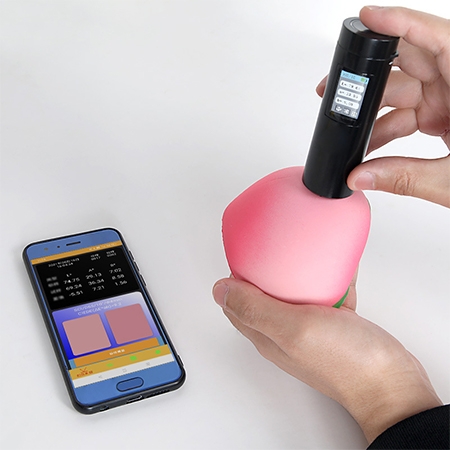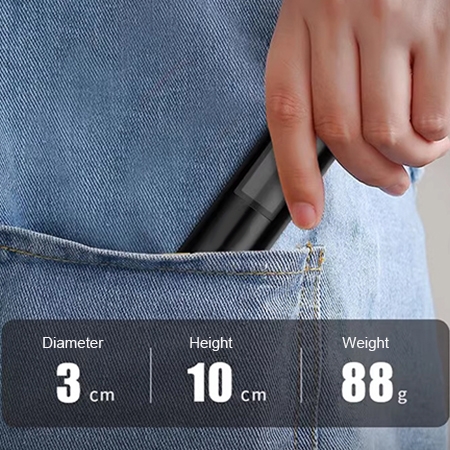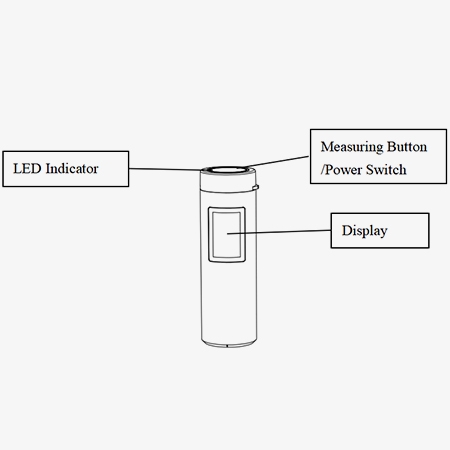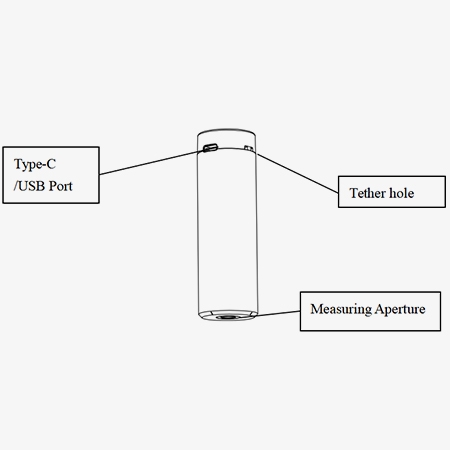The LAB colorimeter's intelligent color matching function quickly locates the closest color and supports viewing LAB values and spectrum charts, facilitating precise color comparison and analysis.

Data Archiving and Cloud Synchronization
- The built-in Bluetooth module provides stable, low-latency connectivity, allowing your phone to connect instantly to the dedicated app. One-click creation of a personal color database is supported, allowing manual entry of skin tone or makeup shades, and data categorized into tags (e.g., "foundation" or "clothing") for convenient search and retrieval.
- Measurement data is uploaded to the cloud in real time and can be viewed simultaneously on mobile, tablet, and computer. This allows R&D teams to synchronize test data and collaborate with colorists across regions for efficient version adjustment. Historical revisions are traceable to prevent data loss.

Long-lasting Battery Life and Portability
- The pocket colorimeter is equipped with a lightweight 800mAh battery that supports direct USB-C charging (full in 1.5 hours) and is compatible with power banks and computers for emergency power. A low-battery LED indicates a red light to prevent measurement interruptions. Direct USB connection to a PC allows for simultaneous export of measurement data, and the accompanying software automatically generates color difference analysis reports, enhancing office efficiency.
- The colorimeter instrument is equipped with a high-definition LCD display, and the data is clear and intuitive. The compact size fits easily in your pocket, allowing for convenient portability and accurate measurement anytime, anywhere.
Application
The colorimeter can easily achieve accurate color transmission and can also be used as precision color testing equipment. It is widely used in plastic, electronics, paint, ink, textile and garment, printing and dyeing, printing paper, automotive, medical, cosmetic and food industries, research institutes, schools and laboratories.
| Model | SISCO-CM-CR4501 |
| Measuring Range | L*:0-100 |
| Measurement Time | 1.5s |
| Power Supply | 800mAh |
| Packaged Weight | 0.5kg |
Structure diagram


Q1: How does a colorimeter work?
A1: Colorimeters rely on the concept of the Beer-Lambert law, which assumes that the absorbance of a substance is proportional to its concentration. For example, the higher the concentration of a solution, the higher the absorbance reading. Many chemical and biological experiments are based on this concept. To obtain a Beer's law curve, several standards (solutions of known concentration) are prepared and their absorbance values are determined using a colorimeter.
Q2: What is colorimetry?
A2: A colorimeter is a device that measures light absorbance (how much light is absorbed) and light transmission (how much light passes through) in a liquid by analyzing the intensity of the color.
Q3: What are the limitations of a colorimeter?
A3: One limitation of chemical colorimeters is that differences in certain substances may lead to inaccurate test results. According to Global Water Instrumentation, because these differences are different for each substance, a chemical colorimeter alone is not a completely foolproof testing device.
Tips: How to Correctly Interpret LAB Test Results?
To interpret LAB test results, you need to pay attention to three parameters: L° represents lightness (0 is black, 100 is white); higher values indicate brightness; A° reflects the red-green bias (positive values indicate red, negative values indicate green); and B° reflects the yellow-blue bias (positive values indicate yellow, negative values indicate blue). These three values can accurately describe color brightness and hue, allowing you to evaluate product color consistency or color characteristics such as skin tone.
Thank you for buying industrial test and measurement equipment on SISCO.com, all products sold by SISCO and the partner cover a 12 months warranty, effective from the date of receiving the products.
What is covered?
SISCO is responsible for providing free spare parts, and free technical support to assist the customer to repair the defective products until the problem is solved.
What is not covered?
- Product purchased from anyone other than a SISCO store or a SISCO authorized reseller.
- Expendable parts.
- Routine cleaning or normal cosmetic and mechanical wear.
- Damage from misuse, abuse or neglect.
- Damage from use of parts other than SISCO approved.
- Damage from use outside the product’s usage or storage parameters.
- Damage from use of parts not sold by SISCO.
- Damage from modification or incorporation into other products.
- Damage from repair or replacement of warranted parts by a service provider other than a SISCO authorized service provider.
- Damage caused by the application environment not meeting the product usage requirements and the failure to perform preventive maintenance.

